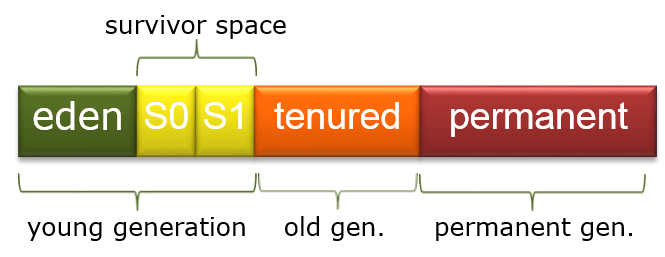Week 9 作業
1) 请简述 JVM 垃圾回收原理
A Definition of Java Garbage Collection
Java garbage collection is the process by which Java programs perform automatic memory management. Java programs compile to bytecode that can be run on a Java Virtual Machine, or JVM for short. When Java programs run on the JVM, objects are created on the heap, which is a portion of memory dedicated to the program. Eventually, some objects will no longer be needed. The garbage collector finds these unused objects and deletes them to free up memory.
How Java Garbage Collection Works
Java garbage collection is an automatic process. The programmer does not need to explicitly mark objects to be deleted. The garbage collection implementation lives in the JVM. Each JVM can implement garbage collection however it pleases; the only requirement is that it meets the JVM specification. Although there are many JVMs, Oracle’s HotSpot is by far the most common. It offers a robust and mature set of garbage collection options.
While HotSpot has multiple garbage collectors that are optimized for various use cases, all its garbage collectors follow the same basic process. In the first step, unreferenced objects are identified and marked as ready for garbage collection. In the second step, marked objects are deleted. Optionally, memory can be compacted after the garbage collector deletes objects, so the remaining objects are in a contiguous block at the start of the heap. The compaction process makes it easier to allocate memory to new objects sequentially after the block of memory allocated to existing objects.
All of HotSpot’s garbage collectors implement a generational garbage collection strategy that categorizes objects by age. The rationale behind generational garbage collection is that most objects are short-lived and will be ready for garbage collection soon after creation.

The heap is divided into three sections:
Young Generation: Newly created objects start in the Young Generation. The Young Generation is further subdivided into an Eden space, where all new objects start, and two Survivor spaces, where objects are moved from Eden after surviving one garbage collection cycle. When objects are garbage collected from the Young Generation, it is a minor garbage collection event.
Old Generation: Objects that are long-lived are eventually moved from the Young Generation to the Old Generation. When objects are garbage collected from the Old Generation, it is a major garbage collection event.
Permanent Generation: Metadata such as classes and methods are stored in the Permanent Generation. Classes that are no longer in use may be garbage collected from the Permanent Generation.
During a full garbage collection event, unused objects in all generations are garbage collected.
The hotSpot has four garbage collectors:
Serial: All garbage collection events are conducted serially in one thread. Compaction is executed after each garbage collection.
Parallel: Multiple threads are used for minor garbage collection. A single thread is used for major garbage collection and Old Generation compaction. Alternatively, the Parallel Old variant uses multiple threads for major garbage collection and Old Generation compaction.
CMS (Concurrent Mark Sweep): Multiple threads are used for minor garbage collection using the same algorithm as Parallel. Major garbage collection is multi-threaded, like Parallel Old, but CMS runs concurrently alongside application processes to minimize “stop the world” events (i.e. when the garbage collector running stops the application). No compaction is performed.
G1 (Garbage First): The newest garbage collector is intended as a replacement for CMS. It is parallel and concurrent like CMS, but it works quite differently under the hood compared to the older garbage collectors.
2)设计一个秒杀系统,主要的挑战和问题有哪些?核心的架构方案或者思路有哪些?
(有時間才做)
版权声明: 本文为 InfoQ 作者【Christy LAW】的原创文章。
原文链接:【http://xie.infoq.cn/article/7fe49eb010fa9e12e7c5846f9】。文章转载请联系作者。












评论